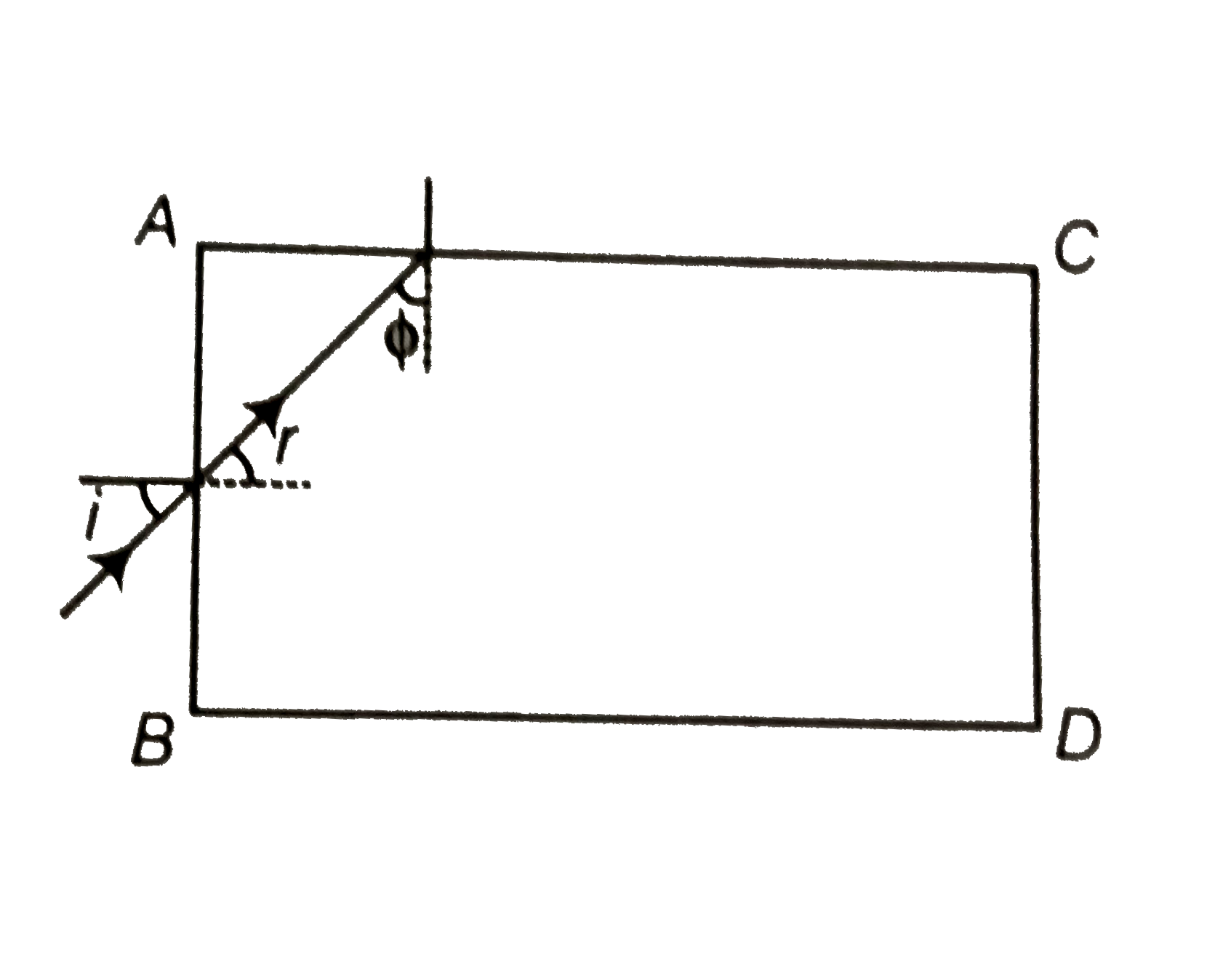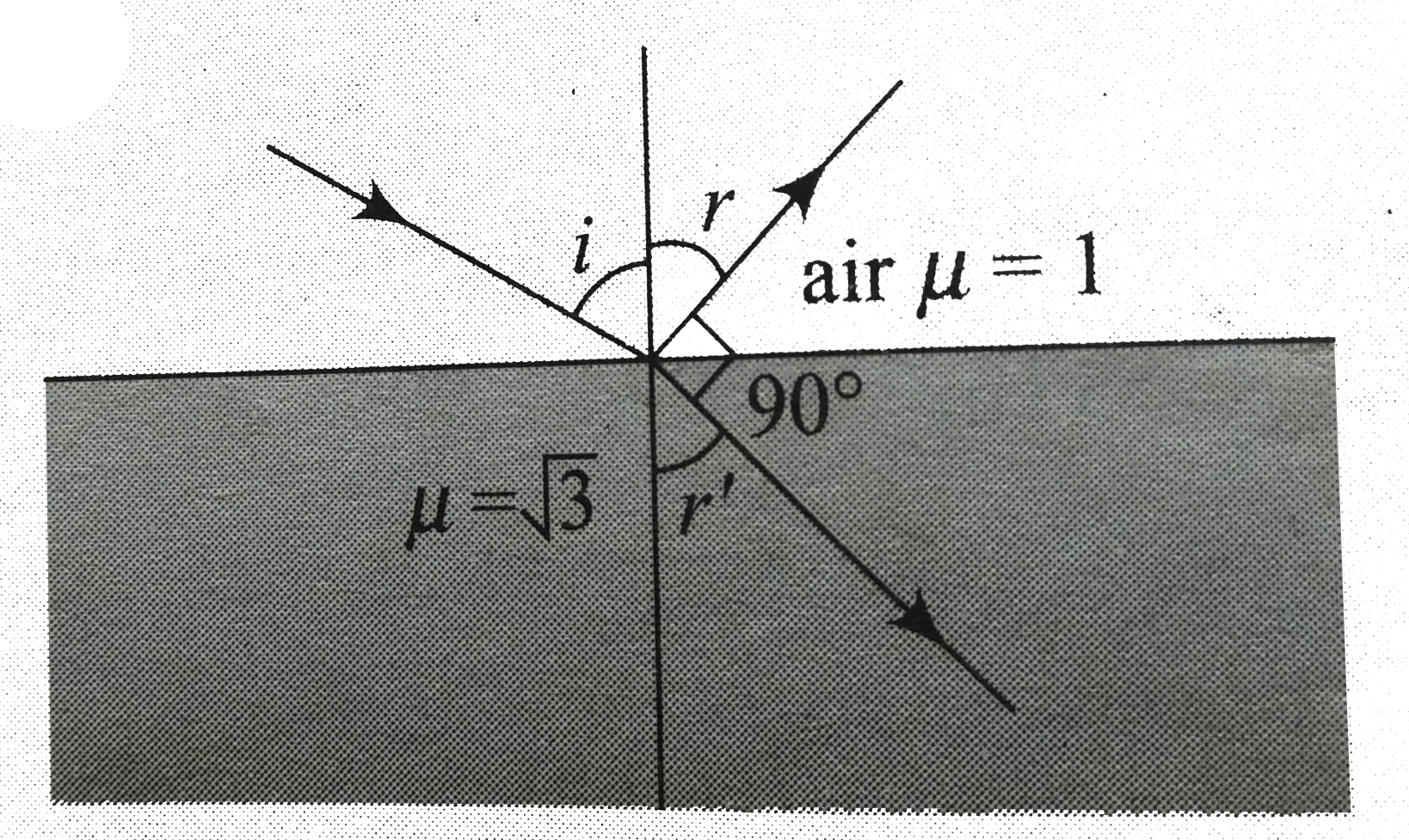Show that for a material with refractive index μ≥√2, light incident at any angle shall be guided along a length perpendicular to the incident face.
Any ray entering at an angle I shall be guided along AC if the angle ray makes with the face AC (ϕ) is greater than the critical angle as per the principle of total internal reflection ϕ+r90∘ , therefore sinϕ=cosr
⇒ sinϕ≥1μ
⇒ cosr≥1μ
or 1−cos2r≤1−1μ2
i.e., sin2r≤1μ2
i.,e, sin2r≤1−1μ2
since, sini−μsinr
1μ2sin2i≤1−1μ2orsin2i≤μ2−1
when i=π2
Then, we have smallest angle ϕ
If that is greater than the critical angle, then all other angles of inidence shall be more than the ciritical angle
Thus 1≤μ2−1
or μ2≥2
⇒ μ≤√2
This is the required result.

Topper's Solved these Questions
- BOOK - NCERT EXEMPLAR ENGLISHCHAPTER - RAY OPTICS AND OPTICAL INSTRUMENTS EXERCISE - MULTIPLE CHOICE QUESTIONS (MORE THAN ONE OPTIONS )6videos
RAY OPTICS AND OPTICAL INSTRUMENTS
- BOOK - NCERT EXEMPLAR ENGLISHCHAPTER - NUCLEIEXERCISE - Long answer type question10videos
NUCLEI
- BOOK - NCERT EXEMPLAR ENGLISHCHAPTER - SEMICONDUCTOR ELECTRONICS: MATERIAL,DEVICES AND SIMPLE CIRCUITEXERCISE - Multiplel choice questions26videos
SEMICONDUCTOR ELECTRONICS: MATERIAL,DEVICES AND SIMPLE CIRCUIT
Similar Questions
Unpolarised light is incident from air on a plane surface of a material of refractive index μ. At a particular angle of incidence i, it is found that the reflected and refracted rays are perpendicular to each other. Which of the following options is correct for this situation?
View SolutionUnpolarised light is incident from air on a plane surface of a material of refractive index .μ.. At a particular angle of incidence .I., it is found that the reflected and refracted rays are perpendicular to each other. Which of the following options is correct for this situation?
View SolutionA ray of light falls on a transparent glass slab of refractive index √2. If the reflected and refracted rays are mutually perpendicular, then the angle of incidence is
View SolutionA ray of light, travelling in a medium of refractive index 'mu_, is incident at an angle i on a composite transparent plate consisting of three plates of refractive indices μ1,μ2andμ3. The ray emerges from the composite plate into a medium of refractive index μ4, at angle x. Then,
View SolutionA ray of monochromatic light is incident on the refracting face of a prism (angle 75∘0 . It passes through the prism and is incident on the other face at the critical angle. If the refractive index of the prism is √2 , then the angle of incidence on the first of the prism is
View SolutionA ray of light is incident on a transparent glass slab of refractive index √3. If the reflected and refracted rays are mutually perpendicular, what is the angle of incidence?
 View Solution
View SolutionUnpolarized light is incident on a plane glass surface having refractive index . The angle of incidence at which reflected and refracted rays would become perpendicular to each other is :
View SolutionA ray of light ravels from a liquid of refractive index μ to air. If the incident beam is rotating at a rate ω , what is the angular sped of the refracted beam at the instant the angle of incidence is 30∘ ? (Given μ=√2,ω=1/√6rads−1).
View SolutionFind the angle of refraction in a medium (μ=2) if light is incident in vacuum, making an angle equal to twice the critical angle.
View SolutionA ray of light is incident on a parallel slab of thickness t and refractive index n. If the angle of incidence θ is small, than the lateral displacement in the incident and emergent ray will be
View Solution

